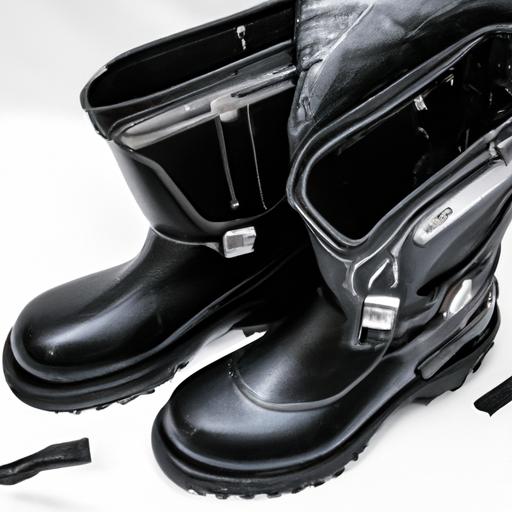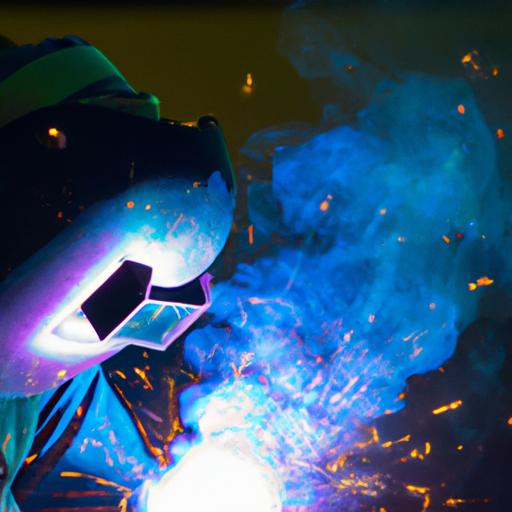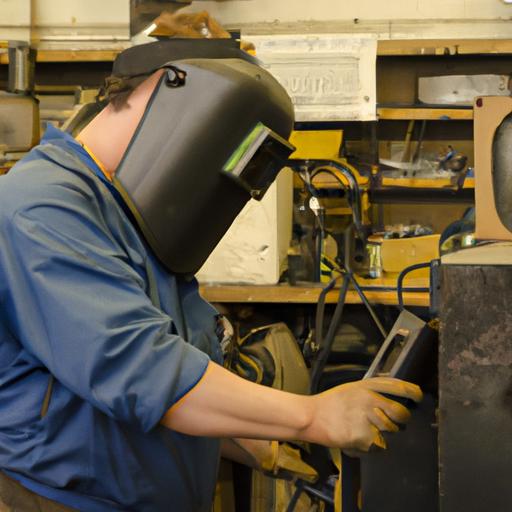Understanding Welding Fumes
Welding fumes are a common byproduct of the welding process, consisting of various airborne particles and gases. It is crucial to comprehend the composition and sources of these fumes, as well as the factors that influence their release.
A. Composition of Welding Fumes
Welding fumes are a complex mixture, primarily composed of metal oxides, gases, and particulate matter. These metal oxides can include hazardous substances such as manganese, chromium, nickel, and lead. When welding different materials, the composition of the fumes can vary, posing different levels of risk. Understanding the specific compounds present in welding fumes is essential for determining their potential harm.
B. Common Sources of Welding Fumes
Welding fumes originate from the process of joining metal parts through the application of heat. Various welding techniques, such as arc welding, gas welding, and resistance welding, can generate fumes. Additionally, the type of metal being welded, the electrode or filler material used, and the presence of coatings or contaminants on the metal surface can also contribute to the emission of welding fumes. It is crucial to identify the specific sources of fumes in order to effectively address the potential health risks associated with them.
C. Factors Influencing the Release of Welding Fumes
Several factors play a role in the release of welding fumes. These include the type of welding process, the welding technique employed, the welding environment, and the ventilation systems in place. The intensity and duration of welding operations, as well as the proximity of workers to the welding process, can significantly impact the concentration of fumes. Additionally, factors such as temperature, humidity, and air movement can affect the dispersion of welding fumes in the surrounding air. Understanding these factors can help in implementing appropriate control measures to minimize exposure to welding fumes.
In the next section, we will delve deeper into the health risks associated with welding fumes and the potential harm they can cause.
Health Risks Associated with Welding Fumes
Welding is a common industrial process that involves joining metals through the application of heat. While it plays an integral role in various industries, it is crucial to understand the potential health risks associated with welding fumes. These fumes are a mixture of airborne particles and gases that are released during welding operations. In this section, we will explore the various health risks posed by welding fumes.
A. Respiratory effects of welding fumes
When welding fumes are inhaled, they can have detrimental effects on the respiratory system. The inhalation of these fumes can lead to immediate symptoms such as coughing, shortness of breath, and chest tightness. Prolonged exposure to welding fumes can result in chronic respiratory issues.
1. Inhalation hazards
Inhalation hazards are a major concern when it comes to welding fumes. Fine particles present in the fumes can penetrate deep into the lungs, leading to irritation and inflammation. This can cause respiratory symptoms and exacerbate existing respiratory conditions such as asthma or bronchitis.
2. Respiratory diseases linked to welding fumes
Research has shown that exposure to welding fumes increases the risk of developing various respiratory diseases. These include welder’s lung, also known as pneumoconiosis, which is characterized by the accumulation of dust particles in the lungs. Additionally, welders are at a higher risk of developing chronic obstructive pulmonary disease (COPD) and lung cancer due to long-term exposure to welding fumes.
B. Potential carcinogenicity of welding fumes
Another significant concern regarding welding fumes is their potential to cause cancer. Certain components of welding fumes, such as chromium, nickel, and formaldehyde, have been classified as carcinogens by reputable organizations like the International Agency for Research on Cancer (IARC). Prolonged exposure to these substances through welding activities increases the risk of developing lung, kidney, and bladder cancers.
C. Other health issues caused by welding fumes
In addition to respiratory effects and potential carcinogenicity, welding fumes have been associated with various other health issues. These include eye irritation, skin allergies, and neurological effects. The particles in welding fumes can irritate the eyes, leading to redness, itching, and even corneal burns. Skin contact with welding fumes or metal surfaces can cause dermatitis and other allergic reactions. Furthermore, certain compounds in welding fumes, such as manganese, have been linked to neurological disorders like Parkinson’s disease.
Understanding the health risks associated with welding fumes is crucial for both employers and workers in order to implement effective safety measures and minimize exposure. In the next section, we will delve into the legal regulations and standards governing welding fume exposure.
Legal Regulations and Standards for Welding Fume Exposure
Welding fumes can pose significant health risks, which is why it is crucial to establish and adhere to legal regulations and standards to protect workers. In this section, we will explore the importance of these regulations and the measures that can be taken to minimize welding fume exposure in the workplace.
A. Overview of Occupational Exposure Limits
Occupational exposure limits (OELs) are guidelines set by regulatory bodies to define the maximum allowable concentration of hazardous substances in the workplace. These limits are designed to protect workers from the adverse effects of exposure to welding fumes. OELs take into account various factors such as the duration of exposure and the type of fumes involved.
Different countries and regions have their own specific OELs for welding fumes. These limits are often expressed in terms of the concentration of specific substances, such as manganese, chromium, or nickel, which are commonly found in welding fumes. It is essential for employers and workers to be aware of the OELs applicable to their location and ensure compliance.
B. Importance of Compliance with Safety Regulations
Complying with safety regulations is not just a legal requirement; it is also a moral obligation to protect the health and well-being of workers. Failure to meet safety standards can result in severe health consequences, legal issues, and reputational damage for businesses. By adhering to regulations, employers demonstrate their commitment to providing a safe working environment.
To ensure compliance, employers should regularly assess and monitor welding fume exposure levels in the workplace. This can be achieved through air sampling and analysis, as well as implementing proper ventilation systems. Additionally, providing appropriate personal protective equipment (PPE) and training employees on its use is essential in minimizing exposure risks.
C. Measures to Minimize Welding Fume Exposure in the Workplace
Minimizing welding fume exposure requires a combination of engineering controls and administrative measures. Engineering controls include the use of local exhaust ventilation systems to capture and remove fumes at the source. These systems effectively reduce the dispersion of fumes in the workplace, protecting both welders and other employees.
Administrative measures involve implementing proper work practices, such as limiting the duration of exposure, rotating workers to minimize prolonged exposure, and ensuring proper maintenance of equipment. Regular training programs should also be conducted to educate workers on the potential risks of welding fume exposure and the necessary safety precautions to follow.
By following legal regulations, implementing engineering controls, and adopting effective work practices, businesses can significantly reduce welding fume exposure and create a safer work environment for their employees. It is crucial for employers and workers to collaborate in prioritizing safety and ensuring compliance with these standards.
Preventive Measures and Safety Precautions
Welding fumes can pose significant health risks, but there are measures you can take to protect yourself and ensure a safe working environment. By implementing proper preventive measures and safety precautions, you can minimize exposure to welding fumes and mitigate potential harm. Let’s explore some effective strategies:
A. Personal Protective Equipment for Welders
When it comes to welding, wearing the appropriate personal protective equipment (PPE) is crucial. PPE acts as a barrier between you and the harmful fumes, shielding you from their direct contact. Here are some essential PPE items for welders:
-
Respiratory Protection: Invest in respiratory protection devices, such as respirators or masks, specifically designed for welding operations. These devices filter out harmful particles and gases, ensuring that you breathe in clean air.
-
Eye and Face Protection: Welding produces intense light, sparks, and debris that can cause eye and face injuries. Wear a welding helmet with a tinted lens to protect your eyes from harmful UV radiation. Additionally, use safety goggles or a face shield to guard against flying particles and chemical splashes.
-
Protective Clothing: Wear flame-resistant clothing made of materials like leather or cotton to protect your body from sparks, molten metal, and potential burns. Don’t forget to cover your arms and legs with appropriate sleeves and pants.
B. Ventilation Systems and Engineering Controls
To reduce welding fume exposure in the workplace, proper ventilation systems and engineering controls should be in place. These measures help eliminate or minimize the release and spread of welding fumes. Consider the following:
-
Local Exhaust Ventilation (LEV): Install LEV systems, such as fume extractors or hoods, near the welding area. These systems capture and remove fumes directly at the source, preventing their dispersion into the surrounding air.
-
General Ventilation: Ensure the workspace has adequate general ventilation to promote air circulation and dilute any remaining fumes. This could involve opening windows, using fans, or employing air filtration systems.
-
Isolation and Enclosure: If feasible, isolate welding operations in separate, well-ventilated areas or enclosures. This helps contain the fumes and prevents their spread to other workspaces.
C. Training and Education on Welding Fume Safety
Proper training and education on welding fume safety are essential for both employers and welders. By understanding the risks associated with welding fumes and the necessary precautions, you can create a safer work environment. Consider the following steps:
-
Employee Training: Employers should provide comprehensive training programs that cover the hazards of welding fumes, proper use of PPE, and safe welding practices. Regular refresher courses can reinforce knowledge and ensure adherence to safety protocols.
-
Awareness and Communication: Encourage open communication between management, supervisors, and workers regarding welding fume safety. Display informative posters, distribute safety guidelines, and conduct toolbox talks to raise awareness and promote a culture of safety.
Remember, implementing these preventive measures and safety precautions not only protects your health but also safeguards the well-being of your colleagues and the overall workplace environment. Prioritize safety and ensure that welding fumes do not compromise your health and safety.
Conclusion
Understanding the potential harm caused by welding fumes is crucial for the safety and well-being of welders and those working in close proximity. Throughout this article, we have explored the composition of welding fumes, the health risks associated with exposure, legal regulations, and safety precautions to mitigate these risks.
Welding fumes pose serious respiratory hazards, with inhalation being the primary route of exposure. Prolonged exposure to welding fumes can lead to various respiratory diseases such as bronchitis, asthma, and lung cancer. Moreover, the potential carcinogenicity of certain components in welding fumes further emphasizes the need for proactive measures.
To ensure the safety of workers, regulatory bodies have established occupational exposure limits to minimize the risk of harm. Compliance with these regulations is vital for employers and welders alike. Implementing engineering controls and ventilation systems in the workplace can effectively reduce the concentration of welding fumes, while personal protective equipment provides an additional layer of defense.
In conclusion, it is imperative to prioritize safety measures and take necessary precautions to minimize welding fume exposure. By understanding the risks associated with welding fumes and adhering to safety regulations, we can protect the health and well-being of welders and create a safer working environment. Remember, your health is priceless, and prevention is always better than cure.
“The only way to do great work is to love what you do.” – Steve Jobs
Now, I will start writing Section 2.



